Watched December 17-23, 2007 (part two): Ozu and Suzuki
Nagaya shinshiroku / The Record of a Tenement Gentleman (Yasujiro Ozu, 1947)
 Ozu's first post-war film (after a 5 year gap in his career) dealt with one of Japan's most pressing (and least attended to) social problems -- the existence of large numbers of homeless children, who were either war orphans or otherwise lost or abandoned. Here, a young boy, six or so years old (Hohi Aoki) has been found by Chishu Ryu (playing a fortune teller of sorts).
Ozu's first post-war film (after a 5 year gap in his career) dealt with one of Japan's most pressing (and least attended to) social problems -- the existence of large numbers of homeless children, who were either war orphans or otherwise lost or abandoned. Here, a young boy, six or so years old (Hohi Aoki) has been found by Chishu Ryu (playing a fortune teller of sorts). 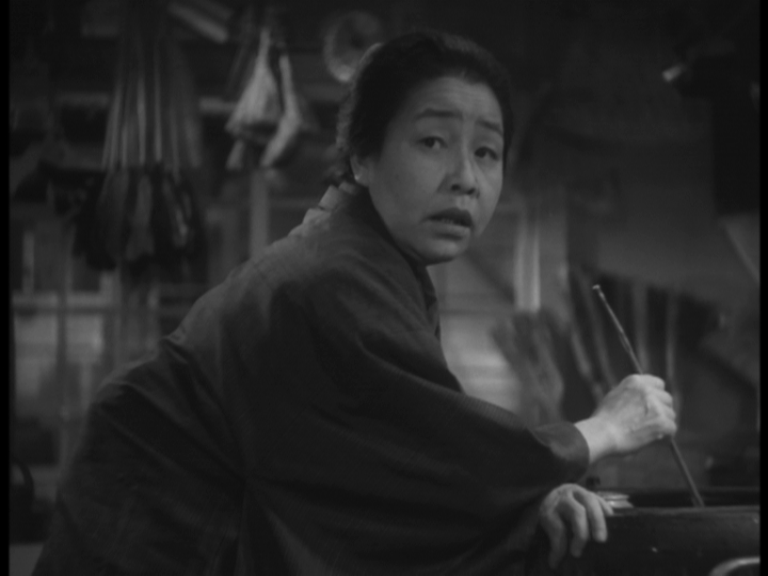 When he brings the boy home to the house where he rents a room, its owner (Reikichi Kawamura) has no interest in housing a stray child. The two decide then decide to palm the boy off on the curmudgeonly shopkeeper who lives across the street (Choko Iida). Iida has no enthusiasm for the proposal, but acquiesces. She is chagrined to find that the boy still wets the bed at night -- and tries to track down the boy's missing father.
When he brings the boy home to the house where he rents a room, its owner (Reikichi Kawamura) has no interest in housing a stray child. The two decide then decide to palm the boy off on the curmudgeonly shopkeeper who lives across the street (Choko Iida). Iida has no enthusiasm for the proposal, but acquiesces. She is chagrined to find that the boy still wets the bed at night -- and tries to track down the boy's missing father. 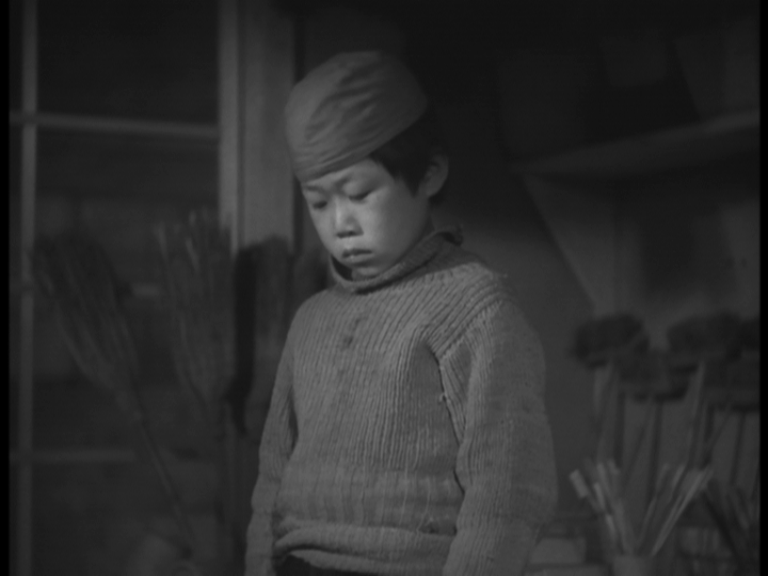 Having no luck in this endeavor, she and the boy return home. After he wets the bed again, the boy runs off. Iida, feeling guilty, looks frantically (but fruitlessly for him) -- but late that night Ryu (having found the boy in the same place he had first encountered him), brings him back.
Having no luck in this endeavor, she and the boy return home. After he wets the bed again, the boy runs off. Iida, feeling guilty, looks frantically (but fruitlessly for him) -- but late that night Ryu (having found the boy in the same place he had first encountered him), brings him back.
 Iida decides that she should, in effect, adopt the homeless boy -- to the amusement of her comparatively well-to-do childhood friend (Mitsuko Yoshikawa), who nonetheless seems to approve of this endeavor (and provides some financial support). After the purchase of new clothes and an outing to the zoo, Iida and the boy go to have a "family" picture taken. That night, however, the boy's father shows up at her house, apologizing for having taken so long to find him (and detailing his own desperate searching).
Iida decides that she should, in effect, adopt the homeless boy -- to the amusement of her comparatively well-to-do childhood friend (Mitsuko Yoshikawa), who nonetheless seems to approve of this endeavor (and provides some financial support). After the purchase of new clothes and an outing to the zoo, Iida and the boy go to have a "family" picture taken. That night, however, the boy's father shows up at her house, apologizing for having taken so long to find him (and detailing his own desperate searching). 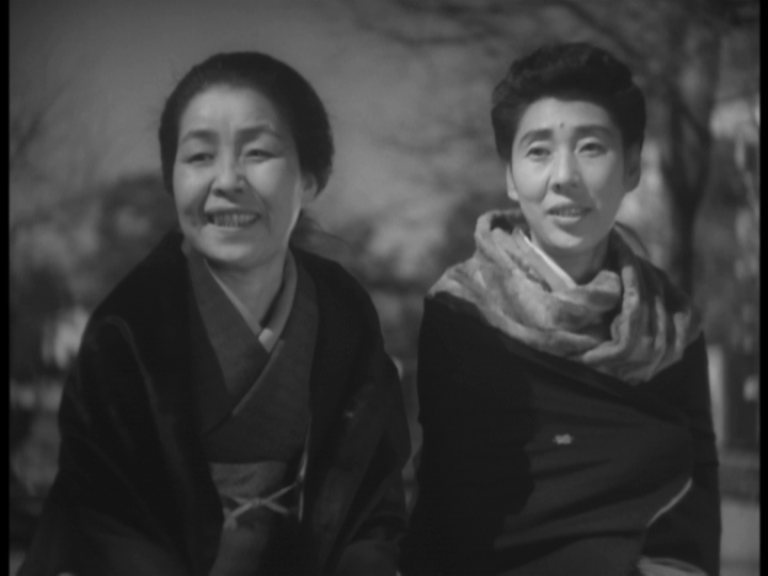 Iida stoically sends the pair off (with new cap, sweater, books etc.), after asking them to visit her now and then. Her neighbors are surprised at how distraught Iida is over the events of the evening. They attribute her tears to her loss of the boy, but she insists that she is actually crying due to her uncharitable thoughts about the "lost" father (who she suspected of abandoning the boy), which she discovered to have been unjustified. She then tells her neighbors (and by extension, the audience) that she now realizes the importance of doing something about all the lost and orphaned children. She can, at least, find another boy who has no family at all and adopt him.
Iida stoically sends the pair off (with new cap, sweater, books etc.), after asking them to visit her now and then. Her neighbors are surprised at how distraught Iida is over the events of the evening. They attribute her tears to her loss of the boy, but she insists that she is actually crying due to her uncharitable thoughts about the "lost" father (who she suspected of abandoning the boy), which she discovered to have been unjustified. She then tells her neighbors (and by extension, the audience) that she now realizes the importance of doing something about all the lost and orphaned children. She can, at least, find another boy who has no family at all and adopt him. 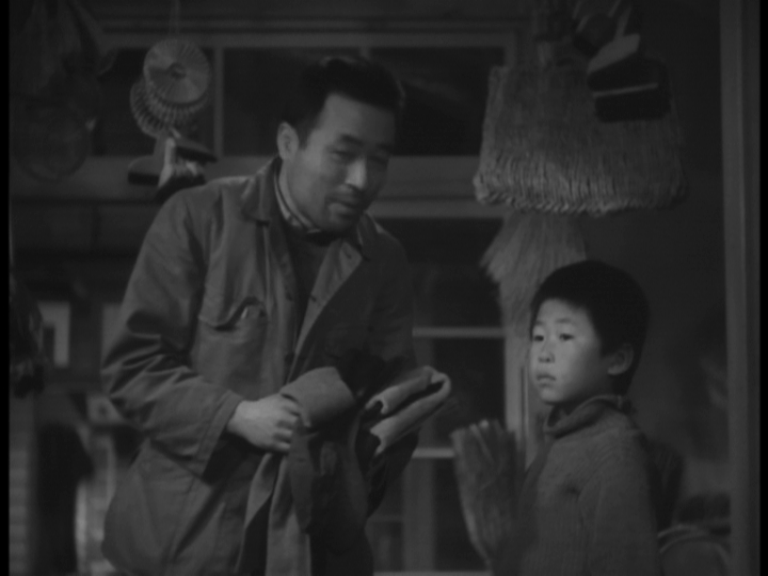 The neighbors are a bit non-plussed by her resolution (and the clear implicatiuon that they too have been failing to meet their obligations to the all too many homeless children of Tokyo), but Ryu points her in the best direction to find a needy orphan. The film closes with shots of homeless boys loitering about the statue of Saigo (in Ueno Park -- near the zoo visited earlier in the film).
The neighbors are a bit non-plussed by her resolution (and the clear implicatiuon that they too have been failing to meet their obligations to the all too many homeless children of Tokyo), but Ryu points her in the best direction to find a needy orphan. The film closes with shots of homeless boys loitering about the statue of Saigo (in Ueno Park -- near the zoo visited earlier in the film).
This first post-war film represented both a new beginning and the end of an era. It was, in essence, a final reunion of most of Ozu's pre-war repertory company -- and his last exploration of the lower working class milieu that was a regular subject in his films of the early (to middle) 1930s.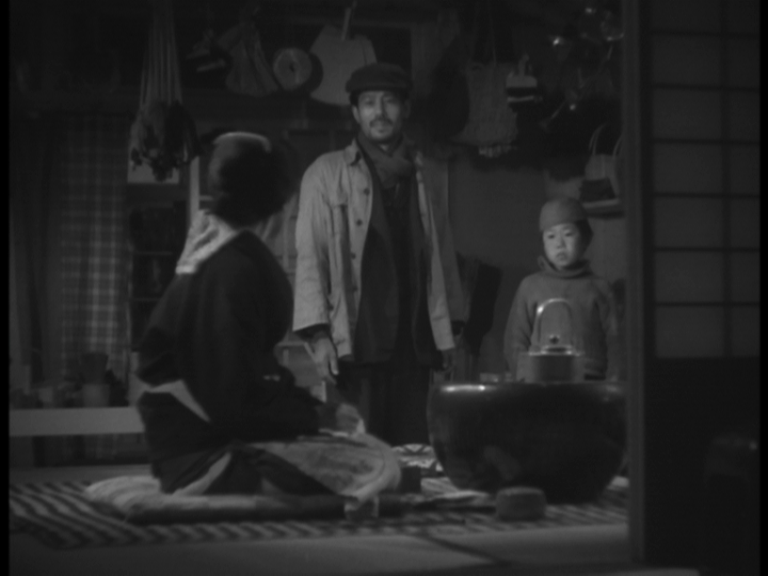 Takeshi Sakamoto makes one last appearance as a character named Kihachi (playing one of Iida's neighbors, a fabric dyer with a flourishing family, who serves as head of the neighborhood committee). While Sakamoto would appear in one more Ozu film, this was the last Ozu appearance for both Iida and Yoshikawa (whose working relationship with Ozu stretched back almost 20 years).
Takeshi Sakamoto makes one last appearance as a character named Kihachi (playing one of Iida's neighbors, a fabric dyer with a flourishing family, who serves as head of the neighborhood committee). While Sakamoto would appear in one more Ozu film, this was the last Ozu appearance for both Iida and Yoshikawa (whose working relationship with Ozu stretched back almost 20 years).
Ozu's film got very little support from its initial audiences. The Japanese government (and public) did not do a good job of dealing with orphaned and abandoned children in the years after the war. As the film suggested, ordinary people seemed too focused on money and material goods to pay much attention to annoying things like homeless children. It would appear that audiences of that day likewise had no interest in being reminded of a moral obligation they had little interest in fulfilling. Despite the film's many charms, it was close to a flop.
As the film suggested, ordinary people seemed too focused on money and material goods to pay much attention to annoying things like homeless children. It would appear that audiences of that day likewise had no interest in being reminded of a moral obligation they had little interest in fulfilling. Despite the film's many charms, it was close to a flop.
Unfortunately, Nagaya shinshiroku also got remarkably little respect in the West for many years.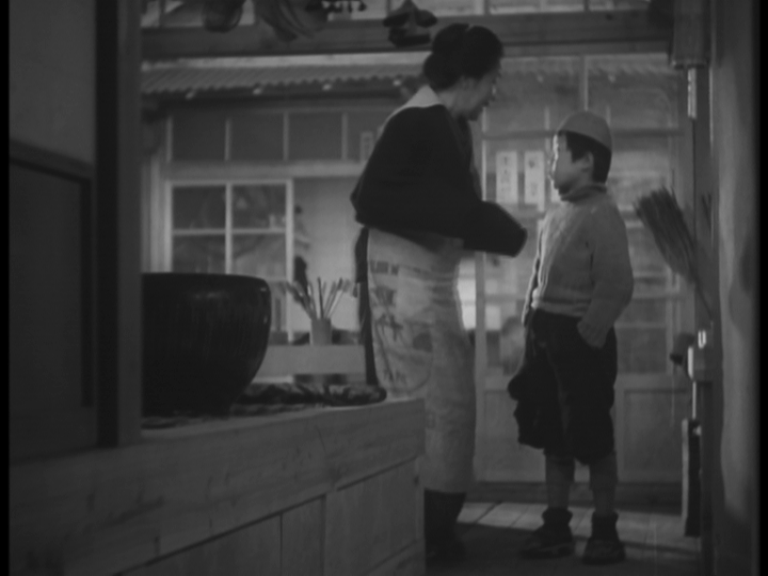 It was probably first mentioned here in Anderson and Richie's The Japanese Film (1959). However, it appears that neither author had actually seen the film. The title was mis-translated into English, based on mis-reading the name as "Nagaya shinshi roku" (Record of a Tenement Gentleman) instead of the correct "Nagaya shinshiroku" (A Who's Who of the Tenement). Even worse, the plot was totally misdescribed:
It was probably first mentioned here in Anderson and Richie's The Japanese Film (1959). However, it appears that neither author had actually seen the film. The title was mis-translated into English, based on mis-reading the name as "Nagaya shinshi roku" (Record of a Tenement Gentleman) instead of the correct "Nagaya shinshiroku" (A Who's Who of the Tenement). Even worse, the plot was totally misdescribed:
This film also got short shrift in in Richie's Ozu (1974):
It would appear that the first American champion of Ozu's long spurned film was David Bordwell. In his 1988, Ozu and the Poetics of Cinema, Bodwell noted: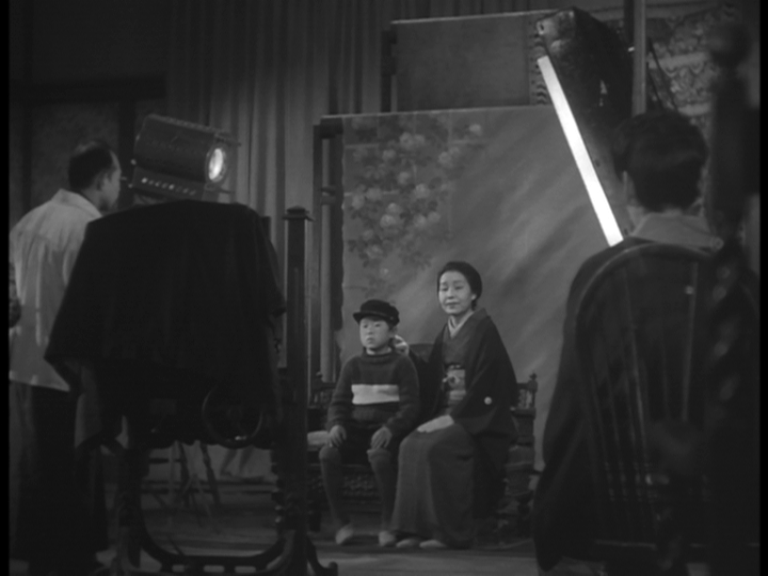 Today, any viewer (with multi-region DVD playing capacity) has his (or her) own opportunity to judge the merits of this film. While the film has yet to show up on DVD in the United States, there are two English-subtitled versions to choose from -- a passable Panorama release from Hong Kong and an even better one from Tartan (UK). I suspect that a Criterion edition will show up in North America one of these years.
Today, any viewer (with multi-region DVD playing capacity) has his (or her) own opportunity to judge the merits of this film. While the film has yet to show up on DVD in the United States, there are two English-subtitled versions to choose from -- a passable Panorama release from Hong Kong and an even better one from Tartan (UK). I suspect that a Criterion edition will show up in North America one of these years.
On last note, fans of Takeshi Kitano's Kikujiro, might find this film particularly interesting. This modern film of a curmudgeonly individual (Kitano as a washed-up petty yakuza) saddled with the job of caring for an unprepossessing young boy shows more than a few echoes of Ozu's Nagaya shinshiroku.
Hishu monogatari / A Tale of Sorrow and Sadness (Seijun Suzuki, 1977)
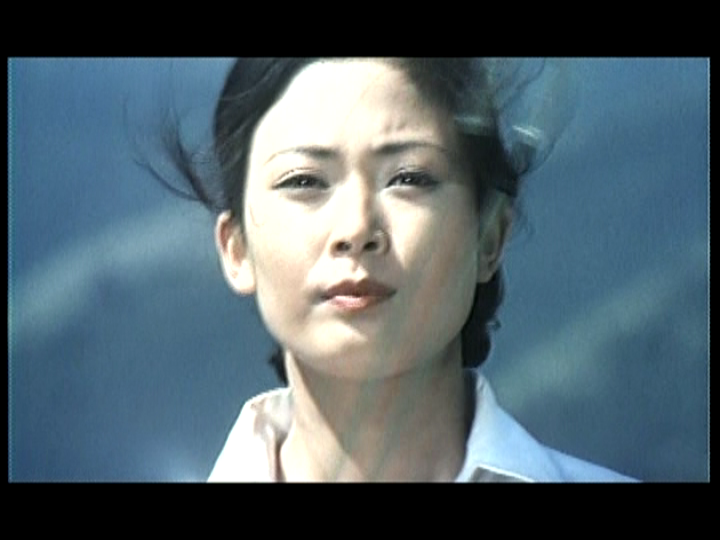 I make no claim of Suzuki expertise. I found his Pistol Opera weird but (mostly) intriguing and I positively love his Operetta tanuki goten (Princess Raccoon), my favorite contemporary movie musical (pace Burton and Sondheim). Beyond that I know nothing but rumors.
I make no claim of Suzuki expertise. I found his Pistol Opera weird but (mostly) intriguing and I positively love his Operetta tanuki goten (Princess Raccoon), my favorite contemporary movie musical (pace Burton and Sondheim). Beyond that I know nothing but rumors.
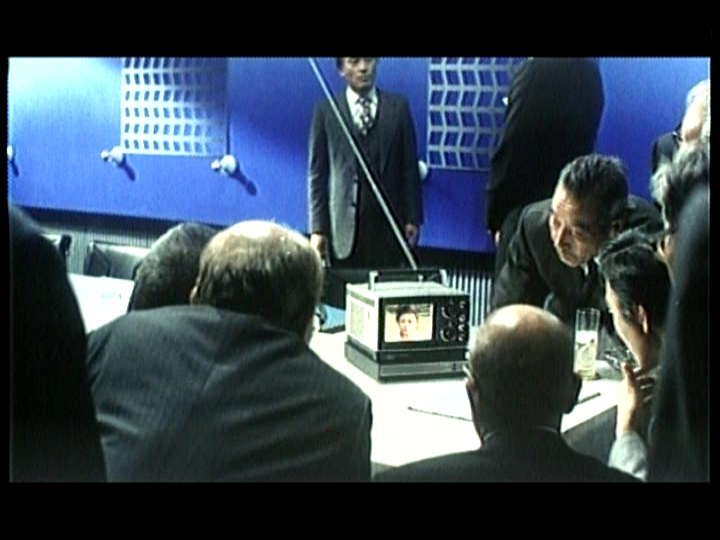 This earlier Suzuki film started off promisingly -- as a send up of modern business (and advertising) in the vein of Masumura's brutal black comedy Giants and Toys (1958).
This earlier Suzuki film started off promisingly -- as a send up of modern business (and advertising) in the vein of Masumura's brutal black comedy Giants and Toys (1958).  Here, some opportunistic businessmen decide to groom a pretty amateur golfer as a golfing star, in order to take advantage of her potential in fashion advertising. The scheme works -- for a while -- and then their lucky victim becomes dispensable.
Here, some opportunistic businessmen decide to groom a pretty amateur golfer as a golfing star, in order to take advantage of her potential in fashion advertising. The scheme works -- for a while -- and then their lucky victim becomes dispensable.
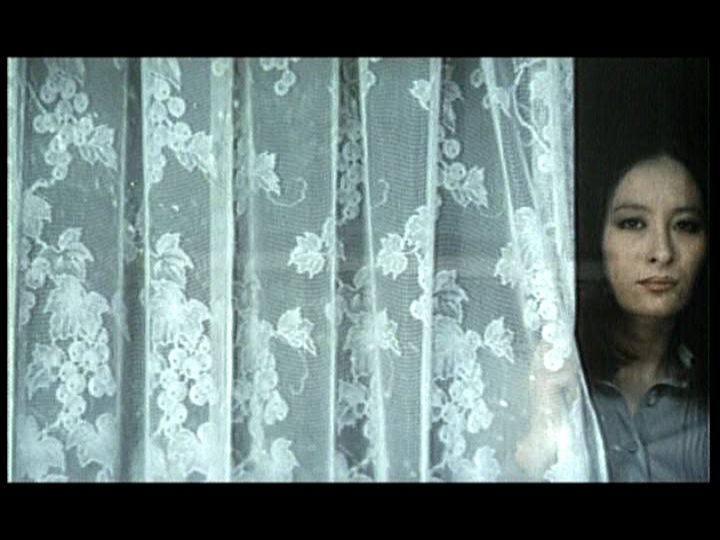 This film begins to get very weird about mid-way through, and then simply becomes more and more random. In addition to the main plot (and the heroine's romantic misadventures),
This film begins to get very weird about mid-way through, and then simply becomes more and more random. In addition to the main plot (and the heroine's romantic misadventures), 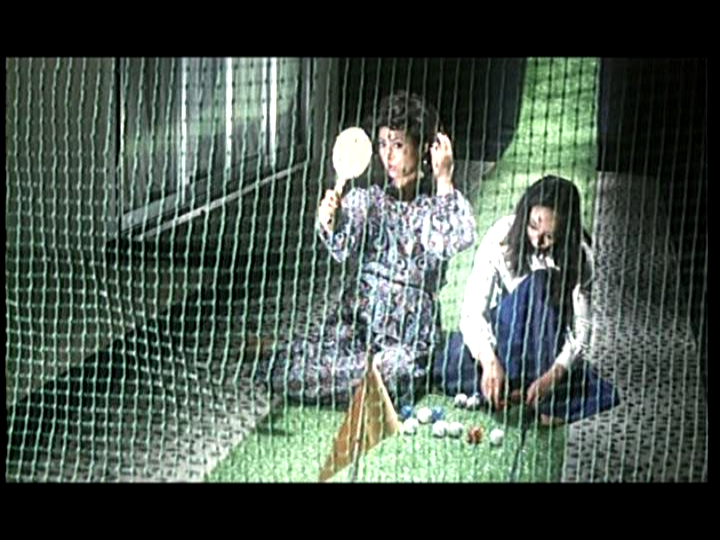 there is a younger school boy brother with a very strange girl friend and a very scary neighbor, who basically takes more and more control over the heroine's crumbling life. By the end, the film has totally run off the road.
there is a younger school boy brother with a very strange girl friend and a very scary neighbor, who basically takes more and more control over the heroine's crumbling life. By the end, the film has totally run off the road.
Unfortunately, much of the random-ness in the latter part of the film is simply not all that interesting, either in terms of story or visual imagery. The most engaging aspect of the film for me was the presence of veteran actor Shuji Sano in his last role (he would die the next year) -- as a grizzled golf professional who resented turning his beloved sport into an advertising opportunity.
either in terms of story or visual imagery. The most engaging aspect of the film for me was the presence of veteran actor Shuji Sano in his last role (he would die the next year) -- as a grizzled golf professional who resented turning his beloved sport into an advertising opportunity.
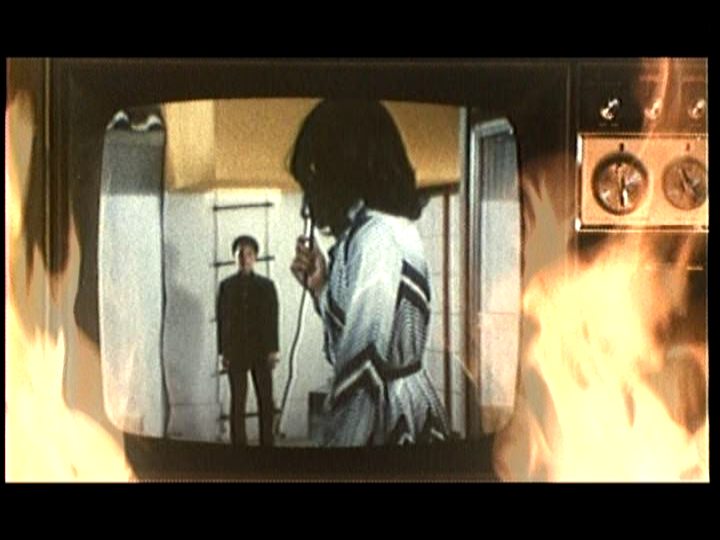 The is available on DVD with English subtitles -- from Panorama (HK). alas, this is a pretty abysmal release. A disappointing release of an even more disappointing film.
The is available on DVD with English subtitles -- from Panorama (HK). alas, this is a pretty abysmal release. A disappointing release of an even more disappointing film.
 Ozu's first post-war film (after a 5 year gap in his career) dealt with one of Japan's most pressing (and least attended to) social problems -- the existence of large numbers of homeless children, who were either war orphans or otherwise lost or abandoned. Here, a young boy, six or so years old (Hohi Aoki) has been found by Chishu Ryu (playing a fortune teller of sorts).
Ozu's first post-war film (after a 5 year gap in his career) dealt with one of Japan's most pressing (and least attended to) social problems -- the existence of large numbers of homeless children, who were either war orphans or otherwise lost or abandoned. Here, a young boy, six or so years old (Hohi Aoki) has been found by Chishu Ryu (playing a fortune teller of sorts).  When he brings the boy home to the house where he rents a room, its owner (Reikichi Kawamura) has no interest in housing a stray child. The two decide then decide to palm the boy off on the curmudgeonly shopkeeper who lives across the street (Choko Iida). Iida has no enthusiasm for the proposal, but acquiesces. She is chagrined to find that the boy still wets the bed at night -- and tries to track down the boy's missing father.
When he brings the boy home to the house where he rents a room, its owner (Reikichi Kawamura) has no interest in housing a stray child. The two decide then decide to palm the boy off on the curmudgeonly shopkeeper who lives across the street (Choko Iida). Iida has no enthusiasm for the proposal, but acquiesces. She is chagrined to find that the boy still wets the bed at night -- and tries to track down the boy's missing father.  Having no luck in this endeavor, she and the boy return home. After he wets the bed again, the boy runs off. Iida, feeling guilty, looks frantically (but fruitlessly for him) -- but late that night Ryu (having found the boy in the same place he had first encountered him), brings him back.
Having no luck in this endeavor, she and the boy return home. After he wets the bed again, the boy runs off. Iida, feeling guilty, looks frantically (but fruitlessly for him) -- but late that night Ryu (having found the boy in the same place he had first encountered him), brings him back. Iida decides that she should, in effect, adopt the homeless boy -- to the amusement of her comparatively well-to-do childhood friend (Mitsuko Yoshikawa), who nonetheless seems to approve of this endeavor (and provides some financial support). After the purchase of new clothes and an outing to the zoo, Iida and the boy go to have a "family" picture taken. That night, however, the boy's father shows up at her house, apologizing for having taken so long to find him (and detailing his own desperate searching).
Iida decides that she should, in effect, adopt the homeless boy -- to the amusement of her comparatively well-to-do childhood friend (Mitsuko Yoshikawa), who nonetheless seems to approve of this endeavor (and provides some financial support). After the purchase of new clothes and an outing to the zoo, Iida and the boy go to have a "family" picture taken. That night, however, the boy's father shows up at her house, apologizing for having taken so long to find him (and detailing his own desperate searching).  Iida stoically sends the pair off (with new cap, sweater, books etc.), after asking them to visit her now and then. Her neighbors are surprised at how distraught Iida is over the events of the evening. They attribute her tears to her loss of the boy, but she insists that she is actually crying due to her uncharitable thoughts about the "lost" father (who she suspected of abandoning the boy), which she discovered to have been unjustified. She then tells her neighbors (and by extension, the audience) that she now realizes the importance of doing something about all the lost and orphaned children. She can, at least, find another boy who has no family at all and adopt him.
Iida stoically sends the pair off (with new cap, sweater, books etc.), after asking them to visit her now and then. Her neighbors are surprised at how distraught Iida is over the events of the evening. They attribute her tears to her loss of the boy, but she insists that she is actually crying due to her uncharitable thoughts about the "lost" father (who she suspected of abandoning the boy), which she discovered to have been unjustified. She then tells her neighbors (and by extension, the audience) that she now realizes the importance of doing something about all the lost and orphaned children. She can, at least, find another boy who has no family at all and adopt him.  The neighbors are a bit non-plussed by her resolution (and the clear implicatiuon that they too have been failing to meet their obligations to the all too many homeless children of Tokyo), but Ryu points her in the best direction to find a needy orphan. The film closes with shots of homeless boys loitering about the statue of Saigo (in Ueno Park -- near the zoo visited earlier in the film).
The neighbors are a bit non-plussed by her resolution (and the clear implicatiuon that they too have been failing to meet their obligations to the all too many homeless children of Tokyo), but Ryu points her in the best direction to find a needy orphan. The film closes with shots of homeless boys loitering about the statue of Saigo (in Ueno Park -- near the zoo visited earlier in the film).This first post-war film represented both a new beginning and the end of an era. It was, in essence, a final reunion of most of Ozu's pre-war repertory company -- and his last exploration of the lower working class milieu that was a regular subject in his films of the early (to middle) 1930s.
 Takeshi Sakamoto makes one last appearance as a character named Kihachi (playing one of Iida's neighbors, a fabric dyer with a flourishing family, who serves as head of the neighborhood committee). While Sakamoto would appear in one more Ozu film, this was the last Ozu appearance for both Iida and Yoshikawa (whose working relationship with Ozu stretched back almost 20 years).
Takeshi Sakamoto makes one last appearance as a character named Kihachi (playing one of Iida's neighbors, a fabric dyer with a flourishing family, who serves as head of the neighborhood committee). While Sakamoto would appear in one more Ozu film, this was the last Ozu appearance for both Iida and Yoshikawa (whose working relationship with Ozu stretched back almost 20 years).Ozu's film got very little support from its initial audiences. The Japanese government (and public) did not do a good job of dealing with orphaned and abandoned children in the years after the war.
 As the film suggested, ordinary people seemed too focused on money and material goods to pay much attention to annoying things like homeless children. It would appear that audiences of that day likewise had no interest in being reminded of a moral obligation they had little interest in fulfilling. Despite the film's many charms, it was close to a flop.
As the film suggested, ordinary people seemed too focused on money and material goods to pay much attention to annoying things like homeless children. It would appear that audiences of that day likewise had no interest in being reminded of a moral obligation they had little interest in fulfilling. Despite the film's many charms, it was close to a flop.Unfortunately, Nagaya shinshiroku also got remarkably little respect in the West for many years.
 It was probably first mentioned here in Anderson and Richie's The Japanese Film (1959). However, it appears that neither author had actually seen the film. The title was mis-translated into English, based on mis-reading the name as "Nagaya shinshi roku" (Record of a Tenement Gentleman) instead of the correct "Nagaya shinshiroku" (A Who's Who of the Tenement). Even worse, the plot was totally misdescribed:
It was probably first mentioned here in Anderson and Richie's The Japanese Film (1959). However, it appears that neither author had actually seen the film. The title was mis-translated into English, based on mis-reading the name as "Nagaya shinshi roku" (Record of a Tenement Gentleman) instead of the correct "Nagaya shinshiroku" (A Who's Who of the Tenement). Even worse, the plot was totally misdescribed: As was seen above, this description has virtually no resemblance to what actually takes place in Ozu's film.
[the film} was about one of many homeless boys who roamed the streets directly after the war. The boy meets his father, but eventually rejects him to go off on hids own and live his own life
This film also got short shrift in in Richie's Ozu (1974):
Audie Bock, in her Japanese Film Directors (1979) continued the Western writing off this film, on the same mistaken basis as Richie -- namely, that Iida's decision to open an orphanage at the end was so "un-Japanese". Noel Burch, writing in the same year in his To the Distant Observer, was more charitable to the film -- he found it to be one of the few post-war Ozu films to have any trace of the value of Ozu's pre-war work. ( Burch considered most post-war Ozu films to be "de-vitalized", due to fossilization of Ozu's style, and thus suitable only to "the amusement and edification of the dilettante").
It was also the first and last time Ozu can be caught making a nod in the direction of civic endeavor, an idea imported from abroad that enjoyed a brief popularity during the Occupation. At the end of the picture, the middle-aged [protagonist] decides to open a center for war orphans like the one she had come to love. This unlikely, one might almost say un-Japanese, resolve almost ruins the film.
It would appear that the first American champion of Ozu's long spurned film was David Bordwell. In his 1988, Ozu and the Poetics of Cinema, Bodwell noted:
Finally, in his A Hundred Years of Japanese Film (2001), Donald Richie made amends for his earlier dismissal of Nagaya shinshiroku, now calling it "one of Ozu's most perfect domestic comedies".
If Ozu had made only this seventy-two minute film, he would have to be considered one of the world's great directors.
 Today, any viewer (with multi-region DVD playing capacity) has his (or her) own opportunity to judge the merits of this film. While the film has yet to show up on DVD in the United States, there are two English-subtitled versions to choose from -- a passable Panorama release from Hong Kong and an even better one from Tartan (UK). I suspect that a Criterion edition will show up in North America one of these years.
Today, any viewer (with multi-region DVD playing capacity) has his (or her) own opportunity to judge the merits of this film. While the film has yet to show up on DVD in the United States, there are two English-subtitled versions to choose from -- a passable Panorama release from Hong Kong and an even better one from Tartan (UK). I suspect that a Criterion edition will show up in North America one of these years.On last note, fans of Takeshi Kitano's Kikujiro, might find this film particularly interesting. This modern film of a curmudgeonly individual (Kitano as a washed-up petty yakuza) saddled with the job of caring for an unprepossessing young boy shows more than a few echoes of Ozu's Nagaya shinshiroku.
Hishu monogatari / A Tale of Sorrow and Sadness (Seijun Suzuki, 1977)
 I make no claim of Suzuki expertise. I found his Pistol Opera weird but (mostly) intriguing and I positively love his Operetta tanuki goten (Princess Raccoon), my favorite contemporary movie musical (pace Burton and Sondheim). Beyond that I know nothing but rumors.
I make no claim of Suzuki expertise. I found his Pistol Opera weird but (mostly) intriguing and I positively love his Operetta tanuki goten (Princess Raccoon), my favorite contemporary movie musical (pace Burton and Sondheim). Beyond that I know nothing but rumors. This earlier Suzuki film started off promisingly -- as a send up of modern business (and advertising) in the vein of Masumura's brutal black comedy Giants and Toys (1958).
This earlier Suzuki film started off promisingly -- as a send up of modern business (and advertising) in the vein of Masumura's brutal black comedy Giants and Toys (1958).  Here, some opportunistic businessmen decide to groom a pretty amateur golfer as a golfing star, in order to take advantage of her potential in fashion advertising. The scheme works -- for a while -- and then their lucky victim becomes dispensable.
Here, some opportunistic businessmen decide to groom a pretty amateur golfer as a golfing star, in order to take advantage of her potential in fashion advertising. The scheme works -- for a while -- and then their lucky victim becomes dispensable. This film begins to get very weird about mid-way through, and then simply becomes more and more random. In addition to the main plot (and the heroine's romantic misadventures),
This film begins to get very weird about mid-way through, and then simply becomes more and more random. In addition to the main plot (and the heroine's romantic misadventures),  there is a younger school boy brother with a very strange girl friend and a very scary neighbor, who basically takes more and more control over the heroine's crumbling life. By the end, the film has totally run off the road.
there is a younger school boy brother with a very strange girl friend and a very scary neighbor, who basically takes more and more control over the heroine's crumbling life. By the end, the film has totally run off the road.Unfortunately, much of the random-ness in the latter part of the film is simply not all that interesting,
 either in terms of story or visual imagery. The most engaging aspect of the film for me was the presence of veteran actor Shuji Sano in his last role (he would die the next year) -- as a grizzled golf professional who resented turning his beloved sport into an advertising opportunity.
either in terms of story or visual imagery. The most engaging aspect of the film for me was the presence of veteran actor Shuji Sano in his last role (he would die the next year) -- as a grizzled golf professional who resented turning his beloved sport into an advertising opportunity. The is available on DVD with English subtitles -- from Panorama (HK). alas, this is a pretty abysmal release. A disappointing release of an even more disappointing film.
The is available on DVD with English subtitles -- from Panorama (HK). alas, this is a pretty abysmal release. A disappointing release of an even more disappointing film.
Comments
I never understood why Ozu's film was named like that but now it all makes perfect sense.
Nagaya,perfect film stuff...